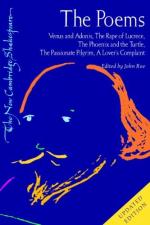|
This section contains 3,196 words (approx. 11 pages at 300 words per page) |

|
SOURCE: Copland, Murray. “The Dead Phoenix.” Essays in Criticism 15, no. 3 (July 1965): 279-87.
In the following essay, Copland claims that The Phoenix and Turtle is a “sad, searching, tender, human, and humane” meditation on the death of Truth and Beauty, and reproaches interpretations that mystify or sentimentalize the poem.
The Phoenix was a striking bird on three counts: (a) its beauty, (b) its uniqueness, and (c) its self-resurrecting habit.
In Shakespeare's poem The Phoenix and Turtle the attribute (a) is prominently present:
Truth and Beautie buried be.
Here Truth = the Turtle, and Beautie = the Phoenix.
As for (b), Robert Chester, whose Love's Martyr prescribed the bare postulates for the poem, had introduced a personal variation of a certain imaginative power. The usual Phoenix is complete in itself; Chester's requires a mate, and finds that mate in a true Turtle. This is not necessarily a muddling idea. If the Phoenix...
|
This section contains 3,196 words (approx. 11 pages at 300 words per page) |

|


